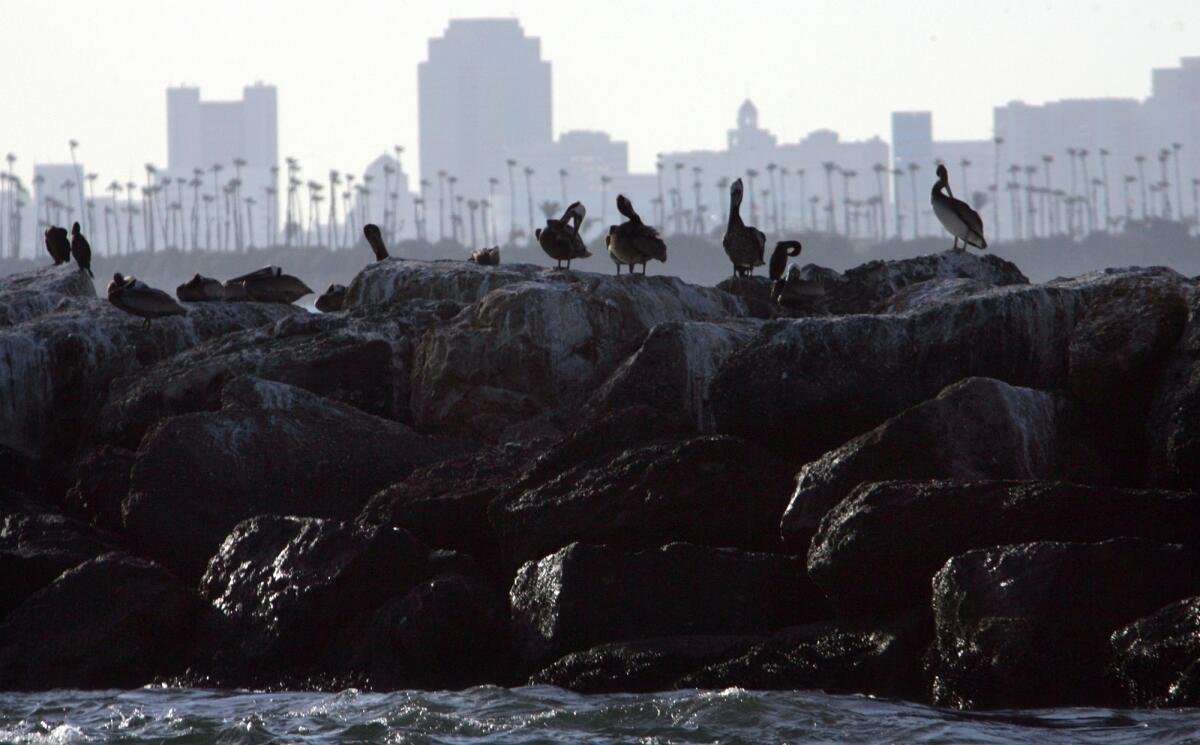Long Beach breakwater study gets funding approval from U.S. Army Corps

With Long Beach visible in the distance, pelicans perch on the breakwater that divides the open sea from Long Beach harbor.
- Share via
The federal government gave a major boost Thursday to the years-long push to bring back crashing waves and cleaner water to the shores of Long Beach.
The city and the U.S. Army Corps of Engineers reached an agreement over the funding of a three-year study on how to restore the ecosystem of East San Pedro Bay, including whether the removal of the 2.2-mile breakwater would improve marine life without posing a danger to nearby infrastructure, the city announced in a statement.
The launch of the $3-million study is a major victory for city leaders and local environmental and recreation groups who have long said the rocky breakwater hemming in the San Pedro Bay has diminished the water quality, hurt marine life and eliminated a beloved benefit of coastal living: the large waves seen elsewhere along California’s shores.
“Improving the coastal experience and ecosystem in our city is a win for residents, visitors, and will be a boost to the Long Beach economy,” Mayor Robert Garcia said in a statement.
A previous city-funded study said that the uptick in tourism and recreation from tearing down parts of the breakwater could draw up to $59 million a year in spending, taxes and parking fees.
The study, slated to begin in early 2016, will look at restoring kelp, eelgrass and wetlands in East San Pedro Bay, with a particular focus on improving the water circulation, city officials said.
The Army Corps’ study will also look at how different restoration strategies, such as reconfiguring the breakwater, could affect coastal residents, the area’s oil islands, and the adjacent Port of Long Beach – one of the nation’s busiest trade and shipping complexes.
Since the breakwater was installed in 1949 – in part to shelter the fleet of U.S. Navy ships in Long Beach – the waves have flattened. As a result, surf-loving crowds have migrated to nearby spots like Huntington Beach or Manhattan Beach.
For several years, city leaders and local congressional representatives have pushed to improve the bay’s water quality and remove parts of the breakwater owned by the Army Corps of Engineers.
But the project has stalled because of difficulty securing federal funds.
In 2009, the city released a $100,000 study that offered five plans to improve the East San Pedro Bay, including three that would reconfigure the breakwater. The priciest option was then estimated to cost about $310 million.
The following year, the Army Corps of Engineers green-lit a four-year, $8.3-million study on altering the breakwater and reconfiguring the mouth of the Los Angeles River. The Long Beach City Council unanimously agreed to pay its portion of that study, $4.1 million, or half the total cost.
But in 2012, the Army Corps changed its format for studying such projects, capping all studies at a $3-million budget over three years.
The city had added in sweeteners to jump-start the project, including an offer to pay half of the Army Corps’ portion, but the study had mostly languished until Thursday’s announcement.
For breaking news in California, follow @MattHjourno.
More to Read
Sign up for Essential California
The most important California stories and recommendations in your inbox every morning.
You may occasionally receive promotional content from the Los Angeles Times.














